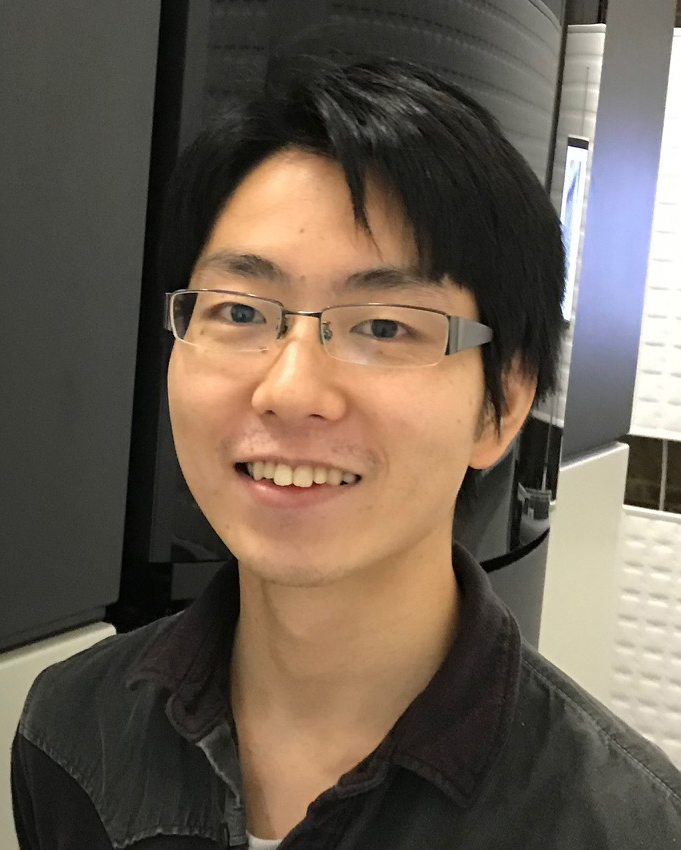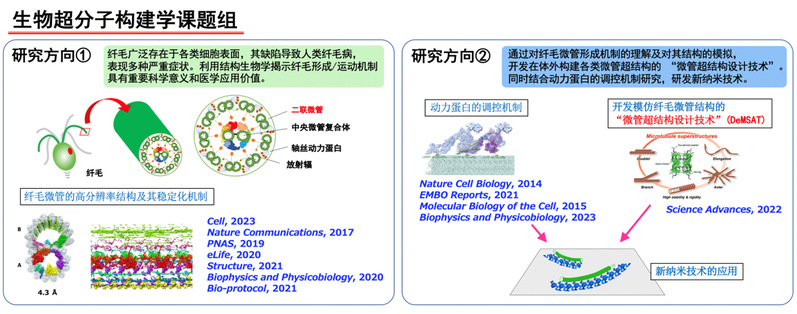
教师基本信息/Basic Information
姓名/Name:市川宗严/ICHIKAWA Muneyoshi
职称/Title:青年研究员, 博师生导师/Tenure-track professor, PhD supervisor
职务/Position:研究组长/PI
电子邮箱/Email address:ichikawa_muneyoshi@fudan.edu.cn
办公地点/Address:
上海市杨浦区淞沪路2005号生命科学学院A201-5
Room A201-5, School of Life Sciences, 2005 hao, Songhu-lu, Yangpu-qu, Shanghai 200438, China
个人简介/Education and Research Background
市川宗严,于2010年获得日本东京大学学士学位。研究生期间,在东京大学丰岛阳子(TOYOSHIMA Yoko)教授的指导下针对动力蛋白(dynein)的结构和功能开展研究,入选日本学术振兴会(JSPS)特别研究员(DC1)后,于2015年获博士学位。作为博士后加入加拿大麦吉尔大学Khanh-Huy Bui课题组工作后,通过冷冻电子显微镜研究纤毛的双微管结构,并入选日本学术振兴会(JSPS)海外特别研究员。2019年,任日本奈良先端科学技术大学院大学助理教授(冢崎智也教授课题组),从事X射线晶体学研究。2020年入选日本科学技术振兴机构(JST)PRESTO项目(约220万元),致力于新型人工微管组装技术的研发。于2022年8月加入复旦大学生命科学学院。
Muneyoshi ICHIKAWA received his bachelor’s degree from The University of Tokyo in 2010. He did his master and doctor course with Prof. Yoko Y. Toyoshima at Graduate School of Arts and Sciences, The University of Tokyo. During this time, he studied the structure and function of motor protein dynein. He was also chosen as a JSPS research fellow (DC1). He was granted his doctor degree in 2015. He then joined Bui lab from McGill University, Canada as a postdoctoral fellow and JSPS overseas research fellow, where he worked on structure of doublet microtubule from cilia by cryo-EM. After that, he did Assistant Professor at Prof. Tomoya Tsukazaki’s lab at Nara Institute of Science and Technology and worked on X-ray crystallography. He obtained a JST PRESTO grant from 2020 (about 2.2 million RMB). He also generated a novel microtubule manipulation technique. He joined School of Life Sciences, Fudan University in August 2022.
研究方向/Research Direction
研究方向1:纤毛蛋白复合体的结构解析
纤毛是附着在真核细胞表面的微小毛发状结构,是一个复杂的9+2结构,由600多种蛋白质组成。纤毛不但对于推动精子等细胞运动非常重要,同时还接收来自外环境的各种信号。因此,纤毛蛋白的缺陷与许多人类疾病有关(纤毛病)。为了了解纤毛的功能和开发新的纤毛病的治疗方法,获取纤毛蛋白复合体乃至整体纤毛的三维结构是至关重要的。
Research Direction1: Structural analysis of ciliary protein complexes. Cilia are tiny hair like structures attached to eukaryotic cell surfaces. Cilia are important for propelling motility of the cells like sperm cells. Cilia also receive signals from outside environment. Thus, defects of ciliary proteins are linked to many human diseases collectively termed as ciliopathy. Cilia have a complex 9+2 architecture and composed of over 600 kinds of proteins. To understand how cilia function and to develop new treatment for ciliopathy, it is crucial to obtain structures of ciliary protein complexes and whole ciliary structure.
研究方向2: 人工微管组装技术——研发操纵微管结构和运动蛋白的新方法 在真核细胞中,微管就像是一条铁路,运动蛋白(如驱动蛋白kinesin和动力蛋白dynein)在微管上行走,运输货物。通过了解微管和运动蛋白的结构和功能,我们可以对这些蛋白进行突变,以实现在材料科学和纳米技术上的新应用。
Research Direction2: Generating novel method to manipulate microtubule structures and motor proteins. In the eukaryotic cells, microtubules serve as a railway and motor proteins, such as kinesins and dyneins walk on microtubules to transport cargoes. By understanding the structures and functions of microtubules and motor proteins, we can genetically engineer these proteins for novel application for material science and nanotechnology.

招生专业/Majors
生物物理和结构生物学/Biophysics and structural biology
获奖情况/Awards and Honors
・2018, 日本生物物理学会青年奖励奖/Early Career Award in Biophysics
・2017, Gérard T. Simon博士奖/Dr. Gérard T. Simon Award
・2016, 青年优秀发表奖/Young Scientist Award
代表性论文和论著/Selected Publications
Gu, Y., Zhao, Y., & Ichikawa, M.*
Tektin makes a microtubule a “micropillar”.
Cell, 186(13), 2725-2727.(2023)
[Preview] [*通讯作者, corresponding author] [一作为复旦大学19级本科生/First author, 2019 grade undergraduate student of Fudan University]
Yagi, T.*, Toda, A., Ichikawa, M., & Kurisu, G.
Regulation of motor activity of ciliary outer-arm dynein by the light chain 1; Implications from the structure of the light chain bound to the microtubule-binding domain of the heavy chain.
Biophysics and Physicobiology, 20(1), e200008. (2023) [Review]
Inaba, H.†*, Sueki, Y.†, Ichikawa, M.†, Kabir, A.M.R., Iwasaki, T., Shigematsu, H., Kakugo, A., Sada, K., Tsukazaki, T. & Matsuura, K.*
Generation of stable microtubule superstructures by binding of peptide-fused tetrameric proteins to inside and outside.
Science Advances, 8(36), eabq3817 (2022) [†共同第一作者, equally contributed]
Kubo, S.†, Yang, S. K.†, Black, C., Dai, D., Valente, M., Gaertig, J., Ichikawa, M.*, & Bui, K. H.*
Remodeling and activation mechanisms of outer arm dyneins revealed by cryo-EM.
EMBO Reports, 22(9), e52911(2021) [*共同通讯作者, co-corresponding authors]
Black, C.†, Dai, D.C.†, Peri, K. Ichikawa, M.*, & Bui, K. H.*
Preparation of Doublet Microtubule Fraction for Single Particle Cryo-electron Microscopy.
Bio-protocol, 11(11), e4041(2021) [*共同通讯作者, co-corresponding authors]
Dai, D., Ichikawa, M.*, Peri, K., Rebinsky, R., & Bui, K.H.*
Identification and mapping of central pair proteins by proteomic analysis.
Biophysics and Physicobiology, 17, 71-85 (2020)[*共同通讯作者, co-corresponding authors]
Khalifa, A.A.Z.†, Ichikawa, M.†, Dai, D., Kubo, S., Black, C.S., Peri, K., McAlear, T.S., Veyron, S.,Yang, S.K., Vargas, J., Bechstedt, S., Trempe, J.F., & Bui, K.H.*
The inner junction complex of the cilia is an interaction hub that involves tubulin post-translational modifications.
eLife, 9, e52760 (2020) [†共同第一作者, equally contributed][获F1000Prime推荐, Recommended in F1000Prime]
Ichikawa, M., Khalifa, A.A.Z., Kubo, S., Dai, D., Basu, K., Maghrebi, M.A.F., Vargas, J., & Bui, K.H.*Tubulin lattice in cilia is in a stressed form regulated by microtubule inner proteins.
Proc. Natl. Acad. Sci. USA, 116(40), 19930-19938 (2019) [第一作者, first author]
Ichikawa, M., Liu, D., Kastritis, P.L., Basu, K., Hsu, T.Z., Yang, S., & Bui, K.H.* Subnanometre-resolution structure of the doublet microtubule reveals new classes of microtubule-associated proteins. Nature Communications, 8, 15035 (2017)[第一作者, first author]
Ichikawa, M., Saito, K., Yanagisawa, H., Yagi, T., Kamiya, R., Yamaguchi, S., Yajima, J., Kushida, Y.,Nakano, K., Numata, O., & Toyoshima, Y.Y.*
Axonemal dynein light chain-1 locates at the microtubule-binding domain of the γ heavy chain. Molecular Biology of the Cell, 26(23), 4236-4247 (2015) [第一作者, first author] [获F1000Prime推荐, Recommended inF1000Prime]
Torisawa, T., Ichikawa, M., Furuta, A., Saito, K., Oiwa, K., Kojima, H., Toyoshima, Y.Y.*, & Furuta,K.* Autoinhibition and cooperative activation mechanisms of cytoplasmic dynein.
Nature CellBiology,16(11), 1118-1124 (2014)

